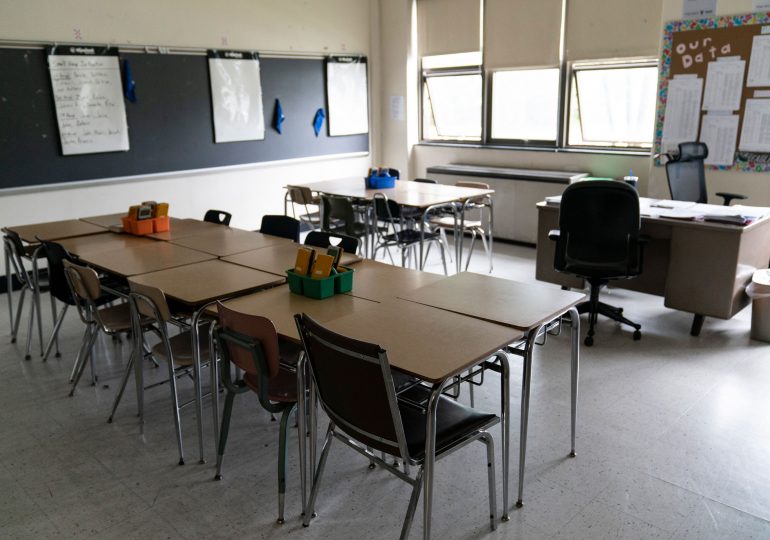Ms. S. teaches English and math in a low-income neighborhood in New York City. She’s one of the most experienced teachers at her school, having been there two years. She has a business degree, but school recruiters kept contacting her after she graduated so she decided to try teaching. “I really enjoy the quality time that I get to spend with these kids,” says Ms. S., who is not using her full name, because she has not been authorized by her school to speak. “They’re a lot of fun to be around.”
[time-brightcove not-tgx=”true”]
But it’s not easy. “The turnover is just so high,” she says. “I think only eight of us returned out of maybe 40 new teachers from last year. And of those people, only maybe five of us are still here.” She’s in a class with 30 students and another teacher, because it’s the integrated co-teaching class, where students with disabilities and those without disabilities learn together. Neither she nor her co-teacher, who just started teaching this year, have any training in education, let alone in instructing children with disabilities.
A constant struggle for Ms. S. is bridging the gulf between the minimal resources available to her and the maximal expectations parents and the school’s administration place on her. Recently the principal of her school (also new this year) brought 15 extra students to her class because they had finished a test earlier than other students. In the chaos, a scuffle broke out. At pickup that day, a mother of one of the students involved publicly railed against Ms. S., and none of her managers were available to help her handle it. “You have to be someone who’s able to take a lot of feedback,” says Ms. S. of her job. “You have to be able to handle stress very well.”
Read More: Many Americans Have No Idea How Their Kids Are Doing in School
Her workday starts at 7 a.m. and finishes at 4:15 p.m.—if parents are on time for pickup. And there always seems to be work after she gets home. “It’s difficult to see other people get home from work and be able to relax and there’s still things that I have to get done,” she says. “I have to call a parent and discuss what happened today, and post the homework and grade the homework every single day. I want to just be social and make dinner and have a nice, enjoyable night, but it’s like there’s so many other things that I’m still behind on, so it’s kind of a constant stress.”
According to newly released research from Pew Research Center, Ms. S.’s experience is widely shared. Pew found the mood among teachers is grim. More than half of respondents would not recommend the career to a young person. More than two-thirds of them said they find teaching overwhelming, perhaps partly because, according to 70% of them, their school is understaffed.
The Pew report, What’s It Like to Be a Teacher in America Today, which was compiled from an online survey of 2,531 U.S. public K-12 teachers in late 2023, also found more than 90% of teachers said poverty, chronic absenteeism, and anxiety and depression were problems in their schools, with about half citing these issues as major problems. Ms. S., who works in a high-poverty area, say her bosses push for results that match schools in less poverty-stricken neighborhoods. “We all try to tell leadership that that’s an unrealistic expectation,” she says. “Our parents are working two jobs and they simply don’t have the time or money to hire tutors, or tutor their kid when they get home from work. If they have night jobs, they’re not around after school.”
But there are student behaviors that make their job even harder. Almost half of the teachers surveyed said students show little to no interest in learning, and the numbers were worse in high school. A third of teachers overall said cell phones are a major distraction—and 77% of high school teachers. Almost 60% of teachers said they have to deal with students’ behavioral issues every day, and the numbers rise as the neighborhood around the school gets poorer. More than two-thirds of teachers in Pew’s survey said they have experienced verbal abuse from a student. And, according to teachers, they can’t rely on parents to help: almost 80% of them told Pew that parents do too little to hold their children accountable for misbehaving in class.
Read More: How to Make School More Equitable for All Students
For Ms. S., the students have been a highlight. She was thrilled when she was able to help one young woman she noticed was bright but misbehaving. “She went from failing at the beginning of the year to passing every single day,” she says. “She just needed someone to believe in her.”
Because of experiences like that, teaching used to be considered one of the most fulfilling careers available, but Pew’s figures show that teachers now have less satisfaction than the average American worker. Reports of low teacher morale have been breaking out everywhere. One 2023 study using Rand data showed the proportion of teachers who said they were enthusiastic about their job plummeted from just over 60% in 2010 to a mere 20% by 2020. And according to Education Week’s new Teacher Morale Index, the mood among elementary-school teachers is particularly low.
The dissatisfaction is partly a byproduct of the pandemic and the widening political divisions that have seen schools becoming battlegrounds. On top of those social frictions are fights over curriculum, rising parental distrust in the public school system, and the increased workload that comes with accommodating the students’ many mental-health challenges. The Pew report illuminates a lot of that discontent, but one figure stands out. Teachers are especially disheartened with what they’re paid; only 15% of public-school teachers say they’re very happy with their salary. Ms. S. notes that her roommates make as much money as she does but don’t have to work when they get home.
The number of people undertaking teacher-training courses dropped 33% in the decade between 2011 and 2021, and a recent study found almost 80% of schools struggled to find enough qualified teachers. And while more than half of teachers still find their job to be fulfilling, a full 30% told Pew it’s likely they’ll look for a new job this academic year and 11% say it’s extremely likely.
As for Ms. S., staying at her school is no longer an option. Her many responsibilities have kept her from keeping up with the master’s program her school requires to continue teaching there. She’ll probably not make it through her exams. “This would have been my third year,” she says. “I actually have some experience. And now that I finally learned how to do it, they’re kicking me out.”
Leave a comment








